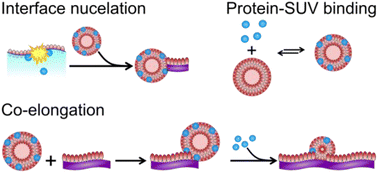Molecular mechanism of α-synuclein aggregation on lipid membranes revealed†
Abstract
The central hallmark of Parkinson's disease pathology is the aggregation of the α-synuclein protein, which, in its healthy form, is associated with lipid membranes. Purified monomeric α-synuclein is relatively stable in vitro, but its aggregation can be triggered by the presence of lipid vesicles. Despite this central importance of lipids in the context of α-synuclein aggregation, their detailed mechanistic role in this process has not been established to date. Here, we use chemical kinetics to develop a mechanistic model that is able to globally describe the aggregation behaviour of α-synuclein in the presence of DMPS lipid vesicles, across a range of lipid and protein concentrations. Through the application of our kinetic model to experimental data, we find that the reaction is a co-aggregation process involving both protein and lipids and that lipids promote aggregation as much by enabling fibril elongation as by enabling their initial formation. Moreover, we find that the primary nucleation of lipid–protein co-aggregates takes place not on the surface of lipid vesicles in bulk solution but at the air–water and/or plate interfaces, where lipids and proteins are likely adsorbed. Our model forms the basis for mechanistic insights, also in other lipid–protein co-aggregation systems, which will be crucial in the rational design of drugs that inhibit aggregate formation and act at the key points in the α-synuclein aggregation cascade.



 Please wait while we load your content...
Please wait while we load your content...